It happens a LOT. You go to a yarn shop or knitting conference, and you encounter those magical walls of luscious hand-dyed knitting yarns. Next thing you know, you’ve got a bag full of multicolored skeins. Can you weave with them? And WHAT can you weave with them?
The bad news is that hand-dyed knitting yarns often aren’t designed with weaving in mind, so the bright colors in a knitting yarn often muddy up into dull colors when woven together, even if they look great in a knitted project. In this blog post, I’ll explain why this happens, and two ways to fix the problem.
Here’s the first problem. Often, you see hand-dyed skeins in the shop just as they were dyed, with the colors all neatly lined up in the skein in big chunks of color:
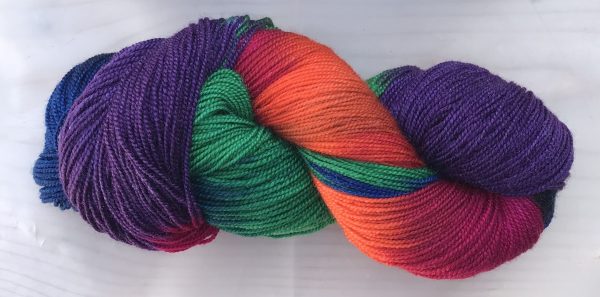
These colors are beautiful, but they don’t look at all the way the colors would appear once wound into a ball, or knitted or woven up. Fortunately, many dyers rewind their skeins to give you a more realistic view of the skein. This dyer has rewound the skein to give you a more realistic view:

This skein doesn’t have quite as much visual appeal as the top skein, but it gives a much more accurate idea of how the colors will blend once knitted or woven up into a finished piece. So when shopping for hand-dyed yarns, I prefer yarns that have been re-skeined after dyeing. It helps me figure out what the colors will look like once I’ve woven up the piece. (The one exception is if I’m planning to weave “faux ikat” with the yarn, lining up the color changes while warping with the yarn. More on that in a little bit.)
Now, one of the difficulties of weaving with hand-dyed knitting yarns is that they are typically designed for knitting, where the colors blend very differently. Knitting produces individual stitches that are more-or-less-square blocks of solid color, placed side by side; weaving produces very thin stripes of color placed right next to each other. As a result, the yarn colors blend together much more in weaving than knitting.
In addition, in weaving, the warp and weft yarns blend together, so the warp color affects the color of the finished piece.
To show the impact, here are the hand-dyed skein we started with at the beginning, a knitted swatch, and a plain weave swatch woven with a black warp and the hand-dyed skein as weft:

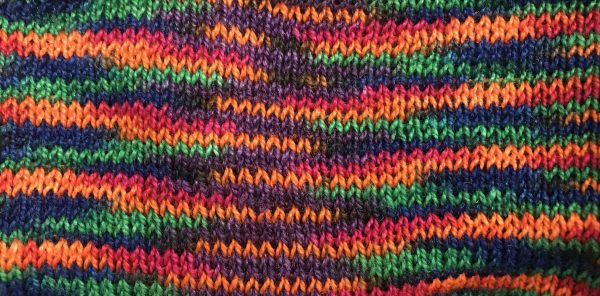
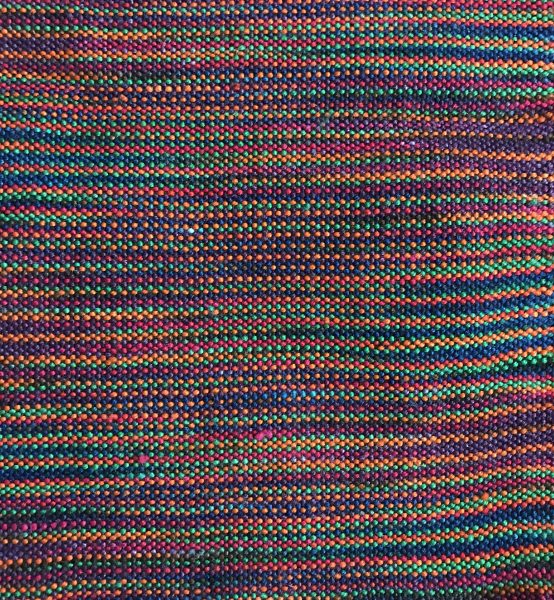
You can see that, while the colors remain bright in the knitted swatch, they are much duller in the woven swatch! That’s because the colors in the woven swatch are mixing together (and are further dulled by mixing with the black warp), while the colors in the knitted swatch are in bigger patches and so stay distinct to the eye.
(This is because of a phenomenon called optical mixing, where the eye blends small dots of color into a single color. Optical mixing is how colors mix in weaving, and why mixing red and green yarns in plain weave gives you brown cloth.)
If you like this effect, no problem! Carry on.
But if you bought the skein because you liked the bright colors and you want them to stay bright, then you have a few options.
Option One: Choose colors that mix into equally bright colors
The first option is to limit yourself to skeins composed of colors that mix into equally bright colors. Colors that follow the “Two-Primary Rule,” that fall in between two primaries on the color wheel, will mix into equally bright colors.
There’s a much fuller discussion of the Two-Primary Rule in this blog post, but basically:
- Cyan (turquoise), blues, greens, and lemon yellow will all mix into equally bright colors;
- Magenta, reds, oranges, and yellows will all mix into equally bright colors
- Magentas, blues, purples, and cyan (turquoise) will all mix into equally bright colors.
Mix colors between those groups in the same skein, and you will get duller colors when woven up.
Here’s a visual depiction of the Two-Primary Rule:
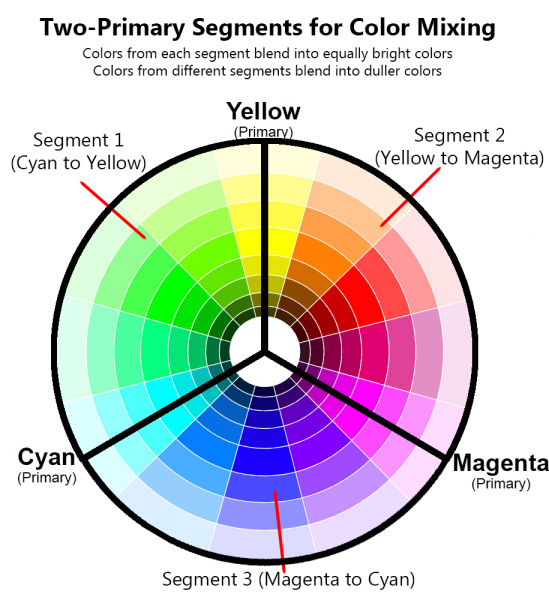
This skein follows the Two Primary Rule (all the colors fall in Segment Three, between cyan and magenta, on the color wheel), so even though all the colors mix together when woven in a plain weave swatch, the colors remain bright.

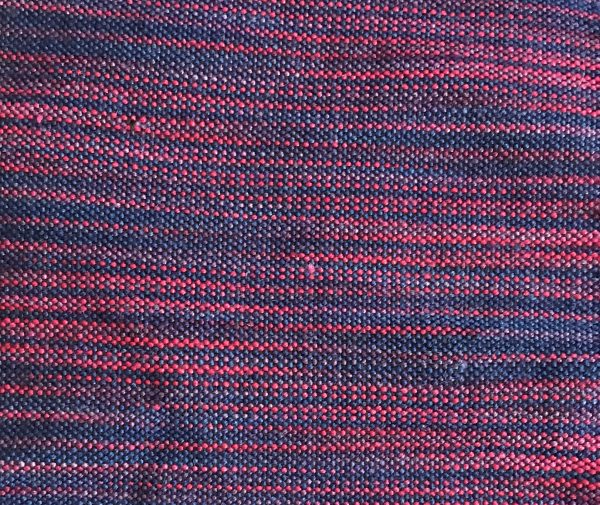
Option Two: Keep the colors from mixing.
If the colors in your skein don’t follow the Two Primary Rule, though, all is not lost! The key now is to keep the colors from mixing with each other. To do that, you either need to separate the colors from each other so they don’t blur together, or get them to “pool” – line up the color changes so they form large blocks of color.
Separating the colors from each other can be as simple as adding a single shot of a different color in between. See how separating the shots of weft yarn makes the colors stand out more?
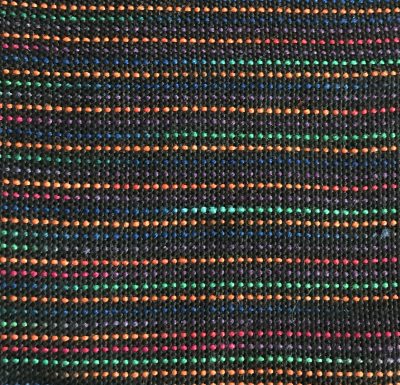
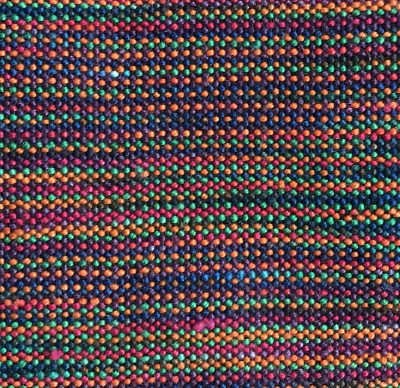
I used black here because it is a neutral color (won’t shift the hue) and a dark color, so it doesn’t attract attention to itself. But other dark, dull colors would also be good candidates – sample to see what works!
Another option is to line up the color changes in the yarn so they “pool” together. Here’s a swatch that shows pooling:

It’s not really practical to do this in the weft because it wastes a lot of yarn (that’s an entire bobbin’s worth of yarn in that teeny-tiny swatch!), but it can be done very effectively in the warp without a great deal of yarn waste. Syne Mitchell explains how to do it in this WeaveZine article.
And that’s it! I get a lot of requests for help with hand-painted yarns, especially hand-painted knitting yarns, so hopefully you’ll find this useful.
Happy weaving,

If you want to know more about how to create crisp, clear designs in your handwoven cloth, subscribe to my newsletter and get my FREE e-book! It will help you design beautiful handwoven fabrics, with a pattern as bold or subtle as you want.


I may have actually squeaked with excitement when I saw what your topic was! I had asked in a FB weavers group about this and was quickly told that there was no way other than trying them to know what they would look like woven. I knew this wasn't true, it should be possible to know. I was even told that if I didn't have the money to spend on experimenting a lot, I should just stick to solid colors.
But you've uncovered the mysteries of how to look at hand dyed yarn and figure out how to weave it beautifully. Thank you sooooo very much for this post!!
You’re welcome! Glad it was helpful for you.
I just cut through a skein of wool and then put it on the loom as warp faced. Then just use tread to weave it and you can see all the beauty in the dyed skein. Like ikat weaving.
Tien, thank you for a very informative article. The color wheel example really makes it crystal clear why and how the colors "play" together. I am a knitter who took up weaving just 2 years ago, and immediately discovered that colors work very differently in woven fabric but wasn't sure why. You've solved the mystery!
Glad to hear you found it helpful! 🙂
Tien, I really enjoyed your blog on the painted yarns. I have a friend that gave me a skein of dyed silk noil. I used black tencel to weave a scarf and it turned out lovely. I had some left over and wove it with white rayon chenille. Not good!!
I belong to a weaving guild and would like to be able to share your information with them. Can I make copies of your article to give them? I won't be offended if you say no. Thanks, June
Absolutely! Go right ahead.
This is great information, I want to learn more and this makes total sense.
Thank you.
Thank you so much for this clear explanation. I am a weaver who always succumbs to the hand painted skeins.
Kathy
Oh my! Why have I never considered the shot of a solid in between to break up the colors? I incorporate that theory all the time in my knitting and I never even considered it for my weaving.
Thank you so much!
Excellent article. Thanks Tien. Looking forward to your class in August
I have a skein of painted yarn that now has a hope of becoming fabric now!
Excellent explanation, looking forward to trying it with the numerous handpainted yarns just sitting in my stash! Thanks so much for sharing this.